Moorcroft was founded as a studio in 1897 by William Moorcroft within the James Mackintyre & Co ceramics company in Stoke-on-Trent.

In 1904, Moorcroft won the gold medal at the St Louis International Exhibition. This was followed by further medals and commendations, and Moorcroft’s pottery quickly became world renowned. By 1912, the inevitable split happened and Moorcroft led his workforce across Cobridge Park to a new factory in Sandbach Road, where Moorcroft pottery is still made today.
Money to start the new factory came from the famous store, Liberty, in London, where it remained in control of Moorcroft until 1962. The Moorcroft name continued to flourish in its new surroundings, such that they became the Potter to HM Queen Mary in 1928.
William Moorcroft died in 1945 and his elder son Walter took over management and design. Combined, William and Walter created 80 new designs under the Moorcroft name, and in 1962, the Moorcroft family bought out Liberty for ownership of Moorcroft. In the following years, the Moorcroft brand fell into difficult times and shares went into the open market. In 1993, the Edwards family took control of Moorcroft and remain so to this day.
Moorcroft’s world profile has greatly improved once again over the past few years, with quality and value at an all-time high. Christie’s hold a Moorcroft sale every year and many national museums now house significant pieces of pottery in their permanent collections, including the V & A Museum
in London.
in London.
Moorcroft pottery is designed by members of the Moorcroft Design Studio – a handful of select artists, each highly skilled to produce the Moorcroft distinctive Art Nouveau style. Its range is vast but includes vases, bottles, picture frames, and lamps. Moorcroft designers also dedicate a large portion of their time in the creation of exclusive designs, and these are sure to become highly valuable collector’s pieces.
Look out for items that are made pre-1945, particularly by those made by William Moorcroft.
Moorcroft collectors should be aware of the Silver Stripe that sometimes appears and is almost always through the WM monogram. The Moorcroft silver stripe denotes a second quality or imperfect piece that has failed to pass the strict quality control that Moorcroft demands. These pieces are only ever sold at discounted prices in the Moorcroft factory shop.
Also be aware, because some silver marks can be removed, Moorcroft now drill a small indent in the base of the item and mark it with a red dot, this is less prone to being removed
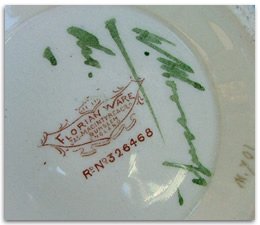
Sometimes with pattern registration number.
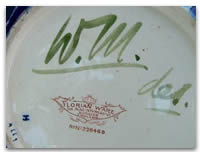
Sometimes with pattern registration number.
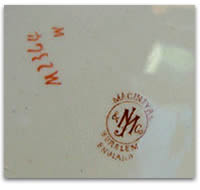
Can also be found in black.
Sometimes with the pattern registration number (Rd No.)
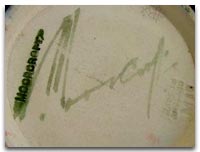
ENGLAND added in 1916. MADE IN ENGLAND added in 1918. Sometimes
with rectangular paper label used for pricing by retailers.
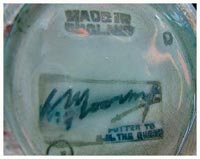
Used prior to and alongside the introduction of the paper label.
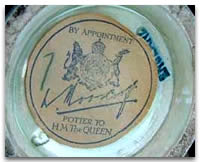
The label was updated in 1936 to read ‘Potter To HM Queen Mary’, following the death of King George V.
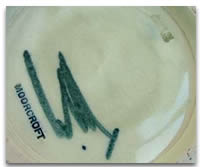
Earlier Walter Moorcroft initials used a slate blue colour to differentiate
it from his father Williams.
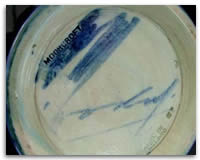
Walters full script signature mark was only used on important pieces,
one off pieces for exhibition or limited editions.
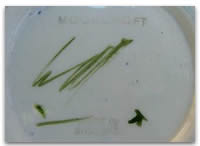
Occurs with and without Walter Moorcrofts monogram
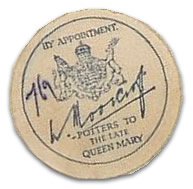
Potters To The Late Queen Mary’.
The Royal warrant expired in 1978 on the anniversary of Queen Mary’s death.
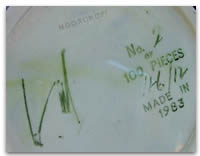
Possibly signed by a paintress as Walter did not sign every single piece.
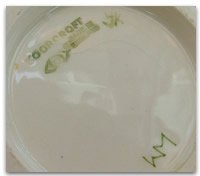
J. Moorcroft appears on large prestigious pieces
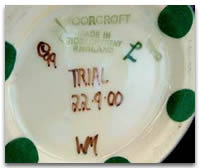
With upper case MOORCROFT and Stoke On Trent above ENGLAND.
With trial date, copyright and WM in brown.
Older trial pieces will not have as much information.
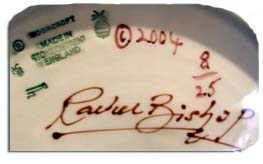
Showing the complexity of the modern mark with full signature, copyright mark and year cypher together with the standard MOORCROFT – MADE IN STOKE ON TRENT – ENGLAND
hope this helps? there is a lot more on the internet to help you, this is just a collective summary.
bottom line is, if you are going to part with a substantial amount of money make sure you are happy, because if you get a great piece of moorcroft it is an excellent investment and something to enjoy :-)
Also be aware, because some silver marks can be removed, Moorcroft now drill a small indent in the base of the item and mark it with a red dot, this is less prone to being removed
Moorcroft Marks (1898-1950)

c1898-1905
Typical early Florian ware mark in brown with handpainted William Moorcroft signature in green with ‘des’ below.Sometimes with pattern registration number.

c1904-1913
Typical early Florian ware mark in brown with handpainted W.M initials in green with ‘des’ below.Sometimes with pattern registration number.

c1904-1913
Common Macintyre & Co, Burslem brown printed mark.Can also be found in black.
Sometimes with the pattern registration number (Rd No.)

c1928-1949
William Moorcroft full signature used from the opening of the Cobridge works along with MOORCROFT and or BURSLEMENGLAND added in 1916. MADE IN ENGLAND added in 1918. Sometimes
with rectangular paper label used for pricing by retailers.

c1928-1949
Impressed stamp mark used with facsimile signature and having ‘Potter to HM Queen’ at bottom right.Used prior to and alongside the introduction of the paper label.

c1928-1953
Early version of the Royal Warrant paper label – ‘Potter To HM The Queen’.The label was updated in 1936 to read ‘Potter To HM Queen Mary’, following the death of King George V.
Moorcroft Marks from – (1950 on)

c1947-1953
Walter Moorcroft initial mark with MOORCROFT and MADE IN ENGLAND.Earlier Walter Moorcroft initials used a slate blue colour to differentiate
it from his father Williams.

c1947-1953
Walter Moorcroft full signature mark.Walters full script signature mark was only used on important pieces,
one off pieces for exhibition or limited editions.

c1950-1986
Large impressed MOORCROFT with upper case MADE IN ENGLAND.Occurs with and without Walter Moorcrofts monogram

c1953 – 1978
Moorcroft Royal Warrant Paper label transferred to Walter Moorcroft in 1946 and stating ‘By AppoinmentPotters To The Late Queen Mary’.
The Royal warrant expired in 1978 on the anniversary of Queen Mary’s death.

c1983
Walter Moorcroft initial mark alongside impressed MOORCROFT on large limited edition Anemone vase.Possibly signed by a paintress as Walter did not sign every single piece.

c1987-
William John Moorcroft initial mark appears now ‘John Moorcroft’ is a director of the company and Walter a consultant.J. Moorcroft appears on large prestigious pieces

TRIAL PIECE MARK
Modern Moorcroft mark depicting a trial piece.With upper case MOORCROFT and Stoke On Trent above ENGLAND.
Older trial pieces will not have as much information.

c2004
Modern Moorcroft mark for artist and designer Rachel Bishop.Showing the complexity of the modern mark with full signature, copyright mark and year cypher together with the standard MOORCROFT – MADE IN STOKE ON TRENT – ENGLAND
hope this helps? there is a lot more on the internet to help you, this is just a collective summary.
bottom line is, if you are going to part with a substantial amount of money make sure you are happy, because if you get a great piece of moorcroft it is an excellent investment and something to enjoy :-)
No comments:
Post a Comment